snowboarding, tuning
Nose and Tail Detuning – What you need to know
Have you ever demoed a snowboard and then bought the same model, but it felt totally different? This could be due to its tuning, or detuning.
Detuning is a broad term that most people have heard from the freestyle world when riding features such as rails or boxes. That detuning is normally referencing the effective edge, in this blog we are talking about the nose and tail of the board.
Boards straight from a factory normally come with sharp 90-degree edges around the whole board. These harsh points on the non-effective edges can disrupt the natural ride of the board by catching during various points of the carve. This would give the board a bigger and stiffer feel. It may even feel like it’s pulling the top or bottom of the board downhill when you are on edge, for example if you’re standing on your backside edge it may feel like you’re really fighting to keep your toes up. Or you may feel like the board won’t release from a carve easily, even after completing a carve fully across the fall line.
Now you’re all “yes, I know exactly what you’re talking about, what now?” Here is what you need to know about getting your new board back to a comfy feel.
Get the tools
The best way to take down metal is with a file. For this purpose, the file doesn’t need to be new as the goal is to round the edge as much as possible. To smooth the edge after a diamond stone can be used and finally a gummy stone to take off any burrs left by the file or diamond stone.

The technique
Making sure you are using your file in the proper direction, so it is biting into the metal, round the sharp edge to a dull point using the file in one direction. This is not a fast process.
Where to file

If you have a twin shaped board you can see where the board bows out before going into the effective edge. The whole edge around the tip and tail and where it runs into the effective edge should be rounded. How far into the effective edge you detune is a personal preference. Around two centimeters down the effective edge is standard, however you may want to detune deeper if the board is still feeling “floppy” as described above. Finding the perfect detune’s slightly experimental depending on the side cut and shape of the board. You may also want to think about the shape of the board in terms of directional vs twin. Based on your style you may want the board biting more in the front verses the back or visa versa depending on how you ride the board. Like snowboarding, this may be a journey of discovery, just remember that it is similar to a haircut, you can’t easily put on edge that you have taken off, but with a full base grind the edge can be brought back to 90 degrees. Take a small file on slope with you to make minor adjustments between runs.
So, remember, the feel of the ride is attributed to many things other then the shape. If it doesn’t feel right try everything before deciding that the board is not for you…especially if you have a new board and are comparing it to a demo board. Our craftsman spend time on every demo board before it goes on snow to a client. We work with the base and edges to make sure the true life of the board can be felt as the designer intended.

